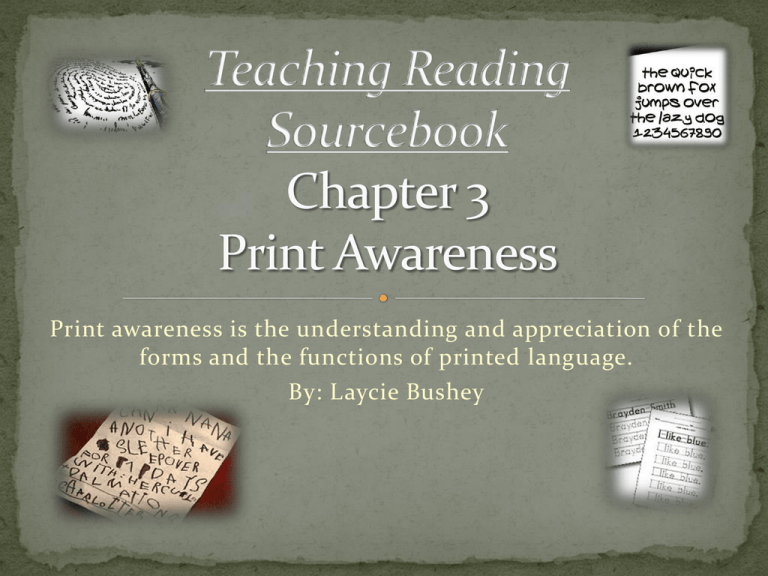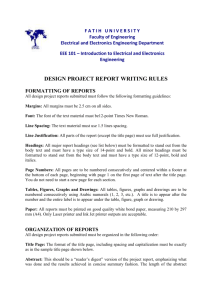Chapter 3 Bushey
advertisement

Print awareness is the understanding and appreciation of the forms and the functions of printed language. By: Laycie Bushey Signs Television Books Logos Labels Newspapers Computers Billboards Calendars Bulletin Boards Functions of Print-Print carries meaning and can be used for different purposes. Print awareness is a child’s earliest introduction to literacy and learning to read. Print corresponds to speech, word for word. Conventions of Print Print is print (no matter the form) Print is made up of letters and are separated by spaces Sentences start with capital letters, are made up of separate words, and end with a punctuation mark. Text is read from left to right, with a return sweep Lines of text are read from top to bottom When one page of text is read, the story continues on the next page. Book Conventions- A book… has a front cover. has a spine. is held right side up. has a title and a title page. has an author; some books have pictures created by an illustrator. has pages. The left page of a book is read before the right page. Pages are turned one at a time in a sequence from front to back. Even though print appears all around, many children arrive at school with little exposure to the uses, methods, or pleasures of print. These things usually do not occur automatically or unaided. A child’s overall awareness of print is the foundation of reading and writing. To expand a child’s early literacy experiences it is important to provide a print-rich environment and use print referencing techniques. Research has shown a definite link between early print concepts and future reading success. Print knowledge is acquired by most children during the preschool years. In preschool and Kindergarten, the enhancement of students’ print awareness should be a central goal (Adams 1990). In Kindergarten, assess print awareness three times: in the fall, winter, and spring. Informal Assessment Questions can be found on page 77 in the Teaching Reading Sourcebook. These assessments can be used to: Adjust the rate of instruction Identify the lowest-achieving students. These students should receive help and careful monitoring in the first six months of school. Create a print-rich environment. Provide plenty of read-aloud experiences. Embed print referencing cues in shared storybook reading. Print referencing is a read aloud strategy that can be used to direct students’ attention to the forms, features, and functions of written language (Justice and Pullen 2003). You can do this with big books or regular-sized story books with large print and 20 words or fewer per page, patterned or predictable text, or print embedded within the illustrations. SO, I have a book, now what do I do? TO DO THIS YOU CAN USE PRINT REFERENCING CLUES in your lesson… Ask questions about print. Talk about the book-Cover, Title, Author, and Illustrator. Concepts of Print-Make comments about print-Words and Spaces, count the words, or words that match pictures. Point to print when talking about the story. Text Directionality-Read from front to back, left to right. Track print when reading. Tracking is to follow along with your finger, pointer, or bookmark while reading. *If more information is needed, a sample lesson is provided on page 79 of the textbook. Here are some additional questions that can be used whole group, small group or individually for observation and assessment of benchmarks: Can you show me the front cover of the book? Can you show me a word? A space? Can you show me where I should start reading on this page? Can you show me which way I should go when I read? When I come to the end of the line, where do I go next? Print awareness is a child’s earliest introduction to literacy. There is a direct link between early print awareness and learning to read. Not all children will come to school with the same print knowledge. Print awareness does not happen automatically or unaided. Adults should point out and talk about the features of print. Create a print-rich classroom, use print referencing techniques, and provide plenty of read-aloud experiences.

![MA Referencing Guidelines for HAHP Assessments [DOCX 14.58KB]](http://s2.studylib.net/store/data/015012327_1-def725262c12765da452af90e7354ba4-300x300.png)









